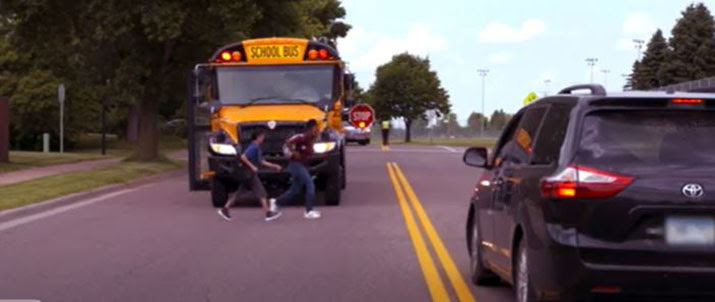School Bus Safety isn’t just for National School Bus Safety Week

If you think about it, there really shouldn’t have to be a week dedicated to school bus safety. After all, children are safer in a school bus than in any other vehicle, despite the fact that school buses in Minnesota make about 10,000 trips a day. And yet, drivers still make poor decisions around school buses, so there’s a week (Oct. 19-23) to remind them of the safe driving behaviors they should engage in all year long.
Part of the issue is that, although children are safe on the bus itself, they need to be safe during the transition on and off the bus. That’s of course why school bus stop arms were invented – and yet, tragically, sometimes they still don’t keep children safe. They can’t unless drivers obey them.
You probably know that if you don’t stop for a school bus when the driver activates the flashing lights and has the stop arm fully extended, you’re breaking the law. But it continues to happen: Over the past five years, law enforcement across the state have written more than 5,700 stop-arm violations. The lightest penalty is a $500 fine, but if you pass a school bus on the right, pass when a child is outside the bus, or injure or kill a child, you face criminal charges.
If you’re wondering how those stop-arm violators were found, remember that many school buses are equipped with video cameras. That way, if a motorist keeps going despite the stop-arm being activated, their vehicle can be identified and the driver can be prosecuted for the violation.
And even though stopping when you see the stop arm go out is pretty common sense, you might want to know some details, such as when and where to stop:
- Stop at least 20 feet from the bus, whether you’re behind it or approaching it from the opposite direction.
- This is true for two-lane roads and two-lane roads with a turning lane in the middle.
- On four-lane roads, always stop when you’re behind the bus. If you’re approaching from the opposite direction, stop unless there’s a median or concrete barrier in the middle.
Remember that it’s the bus driver, not you, who determines whether it’s safe to drive again. So even if you see that the child is safely on the sidewalk, stay put until the bus driver puts the stop arm back in.
So that you’re not taken by surprise, be sure to slow down in neighborhoods and school zones, especially in the morning and mid-afternoon. Always pay careful attention to your surroundings – that means putting distractions away. This video will show you ways to keep from violating stop-arm laws and what happens when people don’t obey them.
If you have school-age kids, it’s important to teach them basic school bus safety. When they’re waiting for the bus, tell kids to stand back from the road and avoid running or other rowdy behavior. When they’re on the bus, they should stay seated, listen to the driver, and use quiet voices. The fewer distractions the driver has, the more safely they can drive.
When kids are exiting the bus, be sure to tell them to look carefully to make sure no cars are passing on the shoulder as they’re getting off the bus. If they have to cross the street in front of the bus, tell them to get where they can see the driver’s face, then wait for them to signal that it’s safe to cross. Kids should look left-right-left before stepping away from the edge of the bus, then continue to watch traffic as they cross.
By observing National School Bus Safety Week all year long, we can work together to make sure that children are just as safe off the school bus as they are when they’re on it.
Bemidji Area Schools Transportation
218-333-3225
Busing Information
- Check Attendance Boundaries (username: guest password: guest)
Bus Rules
- Follow Driver’s Directions the First Time
- Stay Seated – Keep Aisles Clear
- Keep Hands, Feet and Object to Self
- Be Respectful of Others and School Property
- No Loud, Unfit Language or Obscene Gestures
Bus Parking Maps
PDF – School Bus Parking for Each Building
